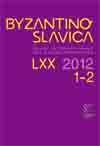Two Byzantine Slabs of Near-Eastern Origin. A New Contribution to Byzantine Iconography
Two Byzantine Slabs of Near-Eastern Origin. A New Contribution to Byzantine Iconography
Author(s): Petr BalcárekSubject(s): History
Published by: AV ČR - Akademie věd České republiky - Slovanský ústav and Euroslavica
Summary/Abstract: The aim of this article is to explore, and make public for the first time, two Byzantine stone slabs which came probably from Syro-Palestine in the Near-East. The style of the slabs is typical of the popular art of local Byzantine workshops and the objects are dated to the end of the 6th or the beginning of the 7th century, i. e to the early stage of the Islamic period. The most valuable feature of these two slabs is their iconographic depiction; on the one, it represents pictorially the missing link in the chain of iconographic depictions of the pelican and, on the other, it represents the traditional antagonistic powers of deathly blood (the bull) and of good, Eucharistic blood of the eternal life (the lion).
Journal: Byzantinoslavica - Revue internationale des Etudes Byzantines
- Issue Year: LXX/2012
- Issue No: 1-2
- Page Range: 131-139
- Page Count: 9
- Language: English
- Content File-PDF

